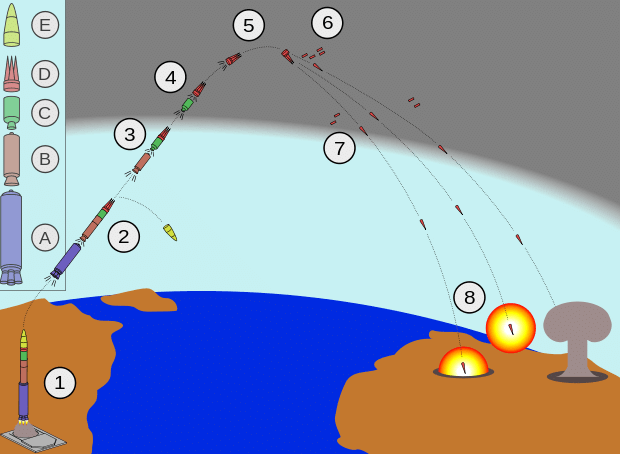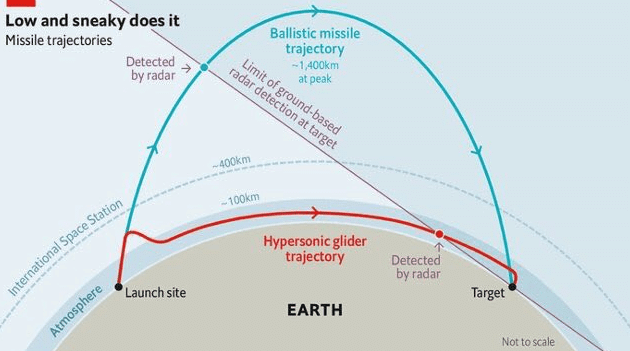Defence Technology in India | Science & Technology for UPSC CSE PDF Download
In UPSC, Mostly questions are asked about issues in current affairs. Since it is of dynamic nature, there is no need to focus too much on the static part.
The focus area should be types of missiles, their working, any upcoming technology, India’s Defence Programme or Strategies related, etc.
We frequently notice news related to ballistic missiles, cruise missiles, and various missile systems of India. Memorizing names and salient features of various Indian missiles is hard without having a broader understanding of the concept of ballistic missiles and cruise missiles, and major missile defence systems. It is better to give these concepts a holistic structure rather than learning them in bits and pieces.
Ballistic Missile and Cruise Missile
The terms ‘ballistic missile’ and ‘cruise missile’ appear in news articles wherever there is a missile test. It is essential for us to understand these terms to understand various Indian missile defence systems.
Ballistic Missile
- A ballistic missile follows a ballistic trajectory to deliver one or more warheads on a predetermined target.
- A ballistic trajectory is the path of an object that is launched but has no active propulsion during its actual flight (these weapons are guided only during relatively brief periods of flight).
- Consequently, the trajectory is fully determined by a given initial velocity, effects of gravity, air resistance, and motion of the earth (Coriolis Force).
- Shorter range ballistic missiles stay within the Earth’s atmosphere.
- Longer-ranged intercontinental ballistic missiles (ICBMs), are launched on a sub-orbital flight trajectory and spend most of their flight out of the atmosphere.
 Ballistic Missile
Ballistic Missile
Types of ballistic missiles based on the range
- Short-range (tactical) ballistic missile (SRBM): Range between 300 km and 1,000 km.
- Medium-range (theatre) ballistic missile (MRBM): 1,000 km to 3,500 km.
- Intermediate-range (Long-Range) ballistic missile (IRBM or LRBM): 3,500 km and 5,500 km.
- Intercontinental ballistic missile (ICBM): 5,500 km +
Cruise Missile
- A cruise missile is a guided missile (target has to be pre-set) used against terrestrial targets.
- It remains in the atmosphere throughout its flight.
- It flies the major portion of its flight path at an approximately constant speed.
- Cruise missiles are designed to deliver a large warhead over long distances with high precision.
- Modern cruise missiles are capable of travelling at supersonic or high subsonic speeds, are self-navigating, and are able to fly on a non-ballistic, extremely low-altitude trajectory.
 Cruise Missile Trajectory
Cruise Missile Trajectory
Types of cruise missiles based on speed
- Hypersonic (Mach 5): these missiles would travel at least five times the speed of sound (Mach 5). E.g. BrahMos-II.
- Supersonic (Mach 2-3): these missiles travel faster than the speed of sound. E.g. BrahMos.
- Subsonic (Mach 0.8): these missiles travel slower than the speed of sound. E.g. Nirbhay.
Differences between Ballistic Missile and Cruise Missile
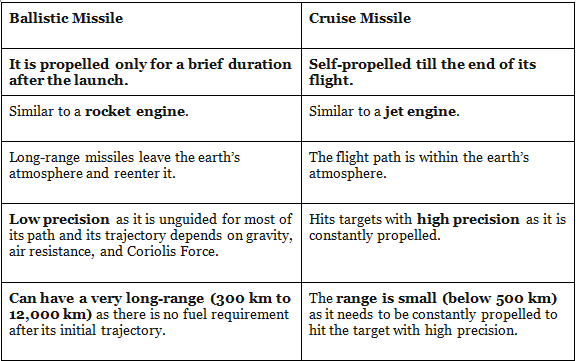
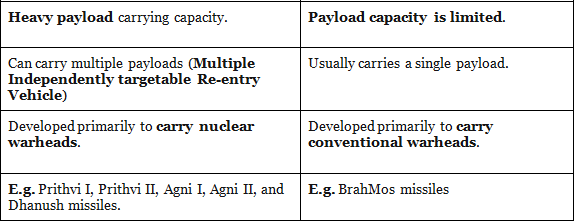
Air to Air Missile (AAM)
Air to Air Missile (AAM) is a missile fired from an aircraft for the purpose of destroying another aircraft or any airborne object.
AAM is broadly classified into 2 types depending on the range factor of the missile.
- Short Range Air to Air Missile (SRAAM) or Within Visual Range Air to Air Missile (WVRAAM) – These Missiles are designed to engage aerial targets within a range of 30 km. Most of these missiles use infrared guidance and are called heat-seeking missiles. These missiles are designed for better agility, hence they are also called dogfight missiles.
- Beyond Visual Range Air to Air Missile (BVRAAM) – These missiles can hit targets beyond the range of 37 Km. These are radar-guided missiles. They don’t use infrared detector since the infrared signatures of aerial targets would be too weak at long ranges.
Astra is the Beyond Visual Range Air to Air Missile (BVRAAM) developed by DRDO (Defence Research and Development Organisation). It can engage aerial targets at a range of 80 km – 110 km. It has been integrated with Sukhoi 30 Mki, Mirage 2000, LCA, MiG-29 fighter aircraft.
India’s Missile Systems
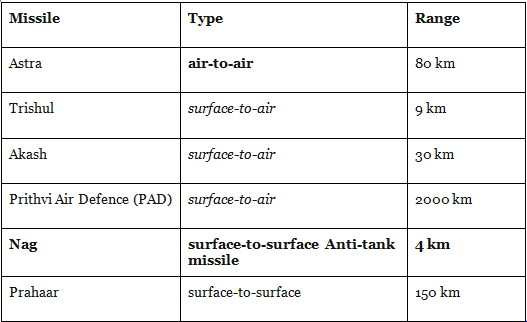
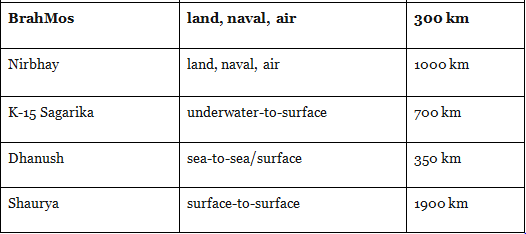


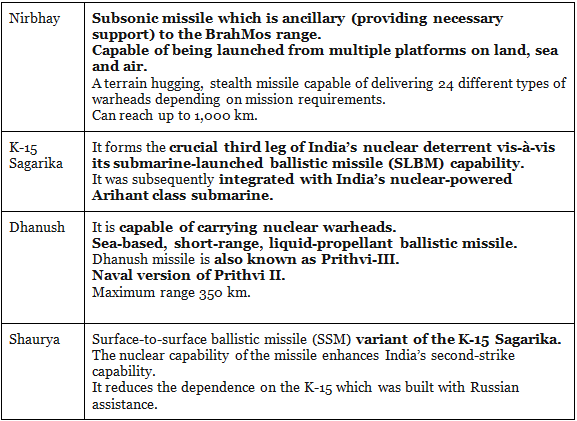
Prithvi Missiles
All the Prithvi variants are surface-to-surface SRBMs (short-range ballistic missile).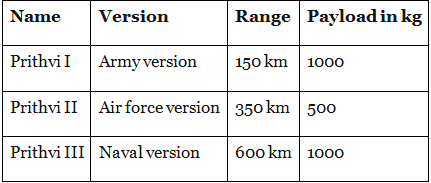
Agni Missiles

MIRV: Multiple Independently targetable Re-entry Vehicle
Anti-satellite weapons (ASAT)
- In March 2019, India successfully tested its ASAT missile.
- The ASAT missile destroyed a live satellite in Low Earth orbit (283-kilometre).
- As per DRDO, the missile is capable of shooting down targets moving at a speed of 10 km per second at an altitude as high as 1200 km.
Integrated Guided Missile Development Program(IGMDP)
- IGMDP was the brainchild of renowned scientist Dr. APJ Abdul Kalam.
- It was intended to attain self-sufficiency in the field of missile technology.
- After keeping in mind the requirements of various types of missiles by the defence forces, the program recognized the need to develop five missile systems.
- The IGMDP formally got the approval of the Indian government on July 26, 1983.
- It brought together the country’s scientific community, academic institutions, R&D laboratories, industries, and the three defence services in giving shape to the strategic, indigenous missile systems.
The missiles developed under IGMDP are:
- Short-range surface-to-surface ballistic missile – Prithvi
- Intermediate-range surface-to-surface ballistic missile – Agni
- Short-range low-level surface-to-air missile – Trishul
- Medium-range surface-to-air missile – Akash
- Third-generation anti-tank missile – Nag
 IGMDP Clasiffication
IGMDP Clasiffication
Agni I
- Single stage, solid fuel, Medium Range Ballistic Missile (MRBM).
- Using solid propulsion booster and a liquid propulsion upper stage.
- Range of 700-800 km.
Agni II
- Intermediate-Range Ballistic Missile (IRBM).
- Range more than 2000 km.
Agni III
- Two stage IRBM
- Support a wide range of warhead configurations.
- Strike range of more than 2,500 Km
Agni IV
- Two stage missile powered by solid propellant.
- Can fire from a road mobile launcher.
- Range is more than 3,500 km.
- Equipped with indigenously developed ring laser gyro and composite rocket motor.
Agni V
- Three-stage solid fueled, indigenous Inter-Continental Ballistic Missile (ICBM).
- Capable of carrying 1.5 tonnes of nuclear warheads.
- Latest and most advanced variant in terms of navigation and guidance, warhead and engine.
- After induction in the military, India will join an exclusive club of countries like the US, Russia, China, France, and Britain which have intercontinental ballistic missile capability.
- Canister launches missile system for operational flexibility.
- Range is more than 5,000 km.
Prithvi
- First indigenously built ballistic missile under IGMDP.
- Surface-to-surface battlefield missile.
- Demonstrates higher lethal effects and high-level capability with field interchangeable warheads.
- Range from 150 km to 300 km.
BrahMos
- The name BrahMos is a portmanteau formed from the names of two rivers, the Brahmaputra of India and the Moskva of Russia.
- Supersonic cruise missile that can be launched from submarines, ships, aircraft, or land.
- It is a two-stage (solid propellant engine in the first stage and liquid ramjet in second) air to surface missile with a flight range of around 300 km.
- However, India’s entry into the Missile Technology Control Regime (MTCR) has extended the range of the BRAHMOS missile to reach 450 km-600km, a shade above its current MTCR capped range of 300 km.
- Manufactured by BrahMos Aerospace Limited, a joint venture between the Defence Research and Development Organisation and Russia’s Military Industrial Consortium NPO Mashinostroyenia.
- Multi-platform cruise can strike from various types of platforms.
- Among the world’s fastest supersonic cruise missiles with speeds ranging between Mach 2.5 – 2.8.
- Brahmos is the heaviest weapon to be deployed on Su-30 MKI fighter aircraft, with a weight of 2.5 tonnes.
- A ‘fire and forget’ weapon i.e. requiring no further guidance from the control centre once the target has been assigned.
MTCR
- The Missile Technology Control Regime was started in 1987 by the G-7 industrialized countries namely, the USA, UK, Canada, France, Germany, Japan, and Italy. It was started to check the proliferation of unmanned delivery systems for nuclear weapons (particularly systems that could carry a payload of 500 kg to a range of 300 km).
- It is not a legally binding treaty on the members. It is only an informal political understanding.
- Currently, there are 35 members in the regime including India. China is not a member of the regime.
- Every member is supposed to establish national export control policies for ballistic missiles, cruise missiles, unmanned aerial vehicles, space launch vehicles, drones, remotely piloted vehicles, sounding rockets, and underlying components and technologies.
- Every member should look into the following five factors while deciding on a possible export of controlled items:
- Whether the intended recipient is pursuing or has ambitions for acquiring weapons of mass destruction;
- The capabilities and purposes of the intended recipient’s space and missile programs;
- The potential contribution the transfer could make to the recipient’s development of delivery systems for weapons of mass destruction;
- The credibility of the recipient’s stated purpose for the purchase; and
- If the potential transfer conflicts with any multilateral treaty.
MTCR and India
India applied for a membership to the MTCR in June 2015. India was supported by the USA and France in its application. India became a member of the MTCR in 2016.
Given below are the benefits of the Missile Technology Control Regime:
- India’s space program will get a fillip as ISRO will now have access to restricted high-end technologies for developing its cryogenic engines.
- India’s arms exports will be enhanced as now, India can export BrahMos to Vietnam, Philippines, and other nations.
- This will help India procure Israel’s Arrow II missile, which will help develop India’s ballistic missile system.
- India can buy surveillance drones from the US.
- This will be a boost to the ‘Make in India’ program.
Pralay
- It is a newly developed surface-to-surface tactical missile.
- The trial of the missile was recently deferred by the Defence Research and Development Organisation (DRDO) due to the cyclone Phethai.
- It is a derivative of Prithvi Defence Vehicle (PDV) exo-atmospheric interceptor which can destroy enemy weapons at high altitudes.
- It has a payload of 1 tonne and it has the capacity to strike targets 350 km away.
- It can travel up to 500 km if the payload is halved.
- It is propelled by solid-fuel rocket.
- It can fly faster than the conventional missiles in its class and can evade ballistic missile defence system.
- It will be launched from its own canister-based transport erector launcher.
Quick Reaction Surface-to-Air missiles (QRSAM)
DRDO has successfully test-fired indigenously developed Quick Reaction Surface-to-Air missiles (QRSAM) from a test range off the Odisha coast.
It has been developed to replace the ‘Akash’ missile defence system, and has 360-degree coverage.
Features
- It uses solid fuel propellant and has a strike range of 25-30 km with capability of hitting multiple targets.
- It is capable of hitting the low flying objects.
- The missile is an all-weather, all-terrain surface-to-air missile equipped with electronic counter measures against jamming by aircraft radars
- The missile can be mounted on a truck and is stored in a canister.
- The missile is equipped with a midcourse inertial navigation system with a two-way data link and a DRDO-developed terminal active seeker. The system has the capability to search and track targets while moving.
- QRSAM is a compact weapon system and is mobile. It has a fully automated Command and Control System. The missile system comprises of two four-walled radars both of which encompass a 360-degree coverage, namely, the Active Array Battery Surveillance Radar and the Active Array Battery Multifunction Radar, apart from the launcher.
Nuclear and Conventional Submarines
The main difference between conventional submarines and nuclear submarines is the power generation system.
Nuclear submarines
Nuclear submarines are powered by a nuclear reactor which is modified for use in a confined , underwater environment. These nuclear reactors produce heat , which in turn produces steam , which works on the steam turbines and turns a shaft. This shaft is connected to the propeller as well as a generator which recharges the battery for onboard use. This nuclear reactor gives them an unlimited range, and the ability to stay underwater for months without surfacing. On-board oxygen generating systems and a large supply of food and water give them a realistic 90 days of continuous underwater time before they need to be re-supplied.
Conventional submarines
Conventional Diesel submarines run on diesel and electricity. They have a huge network of batteries which depend on the diesel generator for charging. These submarines have to surface to charge their batteries. They can also snorkel, which means to travel just below the surface of the water with the periscope and the exhaust pipe above the water surface. Since they become vulnerable when they surface, these subs usually snorkel while charging their batteries. Once they charge the batteries, they dive into the ocean and run silently on battery power with the diesel generators shut down.
A diesel-electric submarine‘s biggest advantage is that it has a smaller hull that is easier to manoeuvre in shallow waters and harder to detect.
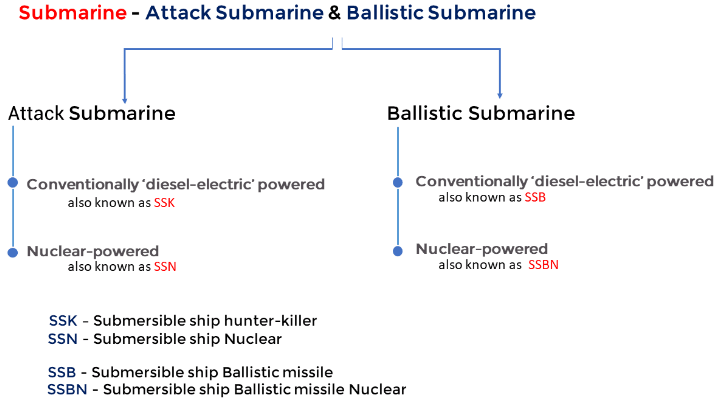 Nuclear and Conventional Submarines
Nuclear and Conventional Submarines
Attack Submarine
An attack submarine or hunter-killer submarine is a submarine specifically designed for the purpose of attacking and sinking other submarines, surface combatants, and merchant’s vessels. In the Soviet and Russian navies, they were and are called “multi-purpose submarines“.
They are also used to protect friendly surface combatants and missile submarines. Some attack subs are also armed with cruise missiles mounted in vertical launch tubes, increasing the scope of their potential missions to include land targets. Attack submarines may be either nuclear-powered or diesel-electric (“conventionally”) powered.
In the United States Navy naming system, and in the equivalent NATO system (STANAG 1166), nuclear-powered attack submarines are known as SSNs and their diesel-electric predecessors were SSKs. In the US Navy, SSNs are unofficially called “fast attacks”.
Ballistic Submarine
A ballistic missile submarine is a submarine capable of deploying submarine-launched ballistic missiles (SLBMs) with nuclear warheads. The United States Navy’s hull classification symbols for ballistic missile submarines are SSB and SSBN – the SS denotes submarine (or submersible ship), the B denotes ballistic missile, and the N denotes that the submarine is nuclear powered.
These submarines became a major weapon system in the Cold War because of their nuclear deterrence capability. They can fire missiles thousands of kilometers from their targets, and acoustic quieting makes them difficult to detect (see acoustic signature), thus making them a survivable deterrent in the event of a first strike and a key element of the mutually assured destruction policy of nuclear deterrence.
Their deployment has been dominated by the United States and the Soviet Union / Russia, with smaller numbers in service with France, the United Kingdom, China, and India.
Akula Class Submarines
- The Akula Class Submarine uses a nuclear reactor for propulsion, allowing it to remain underwater for an extended period of time which makes its detection impossible.
- This class of Submarine can be used for multiple tasks like hunting enemy submarines, intelligence surveillance etc.
INS Chakra
- INS Chakra is a Russia-made, nuclear-propelled, hunter-killer akula class submarine.
- INS Chakra is one of the quietest nuclear submarines around, with noise levels next to zero.
- INS Chakra has been taken on lease from Russia for 10 years and would provide the Navy the opportunity to train personnel and operate such nuclear-powered vessels.
- The INS Chakra joined the Eastern Naval Command at Visakhapatnam in 2012.
INS Arihant
- INS Arihant is the first of five nuclear missile submarines planned for induction.
- It is to be equipped with K 15 (or BO-5) shortrange missiles with a range of over 700 km and the K 4 ballistic missile with a range of 3,500 km.
- At present, the only nuclear – powered platform in service is the INS Chakra, a Akula class SSN on lease from Russia.
- The induction of INS Arihant marks the completion of India’s nuclear triad.
- A nuclear triad refers to the nuclear weapons delivery via land, air and sea i.e. land-based intercontinental ballistic missiles (ICBMs), strategic bombers, and submarine-launched ballistic missiles (SLBMs).
INS Kiltan
- It is the indigenously-built anti-submarine warfare stealth corvette.
- It has been recently inducted into the Indian Navy.
- It is the latest indigenous warship after Shivalik Class, Kolkata Class, and sister ships INS Kamorta and INS Kadmatt.
- It is India’s first major warship to have a superstructure of carbon fiber composite material resulting in improved stealth features.
- The ship derives its name from one of the islands in the Aminidivi group of the Lakshadweep and Minicoy group of islands.
Losharik (AS-12 or AS-31)
- It is a highly advanced Nuclear powered submarine of Russia.
- This week a fire accident was reported on the submarine within the Russian territorial waters.
- It is a deep-diving special missions ship, operated by the Russian Navy.
- It is capable of withstanding high pressures at great depths, enabling it to survey the ocean floor.
- It’s interior hull is built using titanium spheres which makes the vessel dive up to 6000 metres. A regular submarine can go to the depth of only 600 metres.
- It is generally carried under the hull of a larger submarine and is capable of releasing a smaller submarine itself.
- According to Russian military the submarine was carrying out ‘bathymetric measurements’ or underwater mapping.
- But the the US and its allies feared that Russia might be developing new, secretive ways to tap or even cut undersea Fiber-optic cables that carry transatlantic Internet traffic.
- In recent years, U.S. and British military officials have warned that Russian submarines have been spotted close to the cables.
INS Shivalik and INS Sindhukirti
- These are the Indian Navy’s indigenously conceived design and constructed frontline stealth frigate.
- INS Shivalik is the Shivalik-class advanced, stealth-minded, guided-missile frigate warship.
- It is the first stealth warship built by India at Mazagon Dock Limited in Mumbai s part of the Indian Navy’s Project 17.
- It is equipped with a wide range of electronics and sensors.
- In addition, it uses HUMSA (hull-mounted sonar array), ATAS/Thales Sintra towed array systems.
- It is equipped with a mix of Russian, Indian and Western weapon systems.
- It also has improved stealth and land attacking features over the preceding Talwar-class frigates.
- It is the first Indian navy ship to use the CODOG (Combined Diesel Or Gas) propulsion system.
- INS Sindhukirti is the seventh Sindhughosh-class, diesel-electric submarine of the Indian Navy, built at the Admiralty Shipyard and Sevmash in the Soviet Union.
- It is among the oldest operational submarines in the Navy.
- It has been virtually rebuilt with modern sensors weapons and systems which make it “a hole in the water” for the Navy.
INS Sagardhwani
- It is the Oceanographic research vessel of DRDO.
- It is maintained and operated by the Indian Navy.
- It is a ‘Marine Acoustic Research Ship’ (MARS) designed and developed by ‘Naval Physical and Oceanographic Laboratory’ (NPOL), Kochi.
- NPOL is a premier systems laboratory of DRDO.
- The ship is fitted with state-of-the-art equipments like the latest wave height measuring radars, marine radio etc.
- It is exclusively used for the scientific and research programmes of NPOL.
INS Tarkash
- It is a state-of-the-art stealth frigate of the Indian Navy.
- It is the 5th Talwar-class frigate constructed for the Indian Navy, built at the Yantar shipyard in Kaliningrad, Russia.
- It is equipped with a versatile range of weapons and sensors capable of addressing threats in all three dimensions.
INS Nilgiri
- INS Nilgiri is the first ship of the Project-17A.
- Project 17A frigates is a design derivative of the Shivalik class stealth frigates with much more advanced stealth features and indigenous weapons and sensors.
- The P17A frigates incorporate new design concepts for improved survivability, sea keeping, stealth and ship manoeuvrability.
- These frigates are being built using integrated construction methodology.
India’s Aircraft Carrier
- Currently, the Indian Navy opera only a single carrier, the 44,000-tonne INS Vikramaditya bought from Russia.
- INS Vikrant is an indigenous aircraft carrier being built in Cochin Shipyard.
- It is a 40000-tonne carrier and expected to join service by 2021.
- INS Vishal proposed to be India’s 2nd indigenous aircraft carrier has stalled since 2017 awaiting the defence ministry’s clearance.
- It was conceived as a 65,000-tonne class carrier. The clearance was mainly delayed owing to its production cost.
- Recently, the Indian government has approached UK to build a state of the art aircraft carrier along the lines of Britain’s HMS Queen Elizabeth.
- The talks are underway to buy detailed plans for the 65,000-ton British warship to build a so-called “copycat supercarrier” to be named INS Vishal in 2022.
- This India-UK Naval deal would follow the sale of INS Viraat to India in 1987, which was decommissioned 2 years ago.
INS Vishal
- INS Vishal, also known as Indigenous Aircraft Carrier 2(IAC-2), is a planned aircraft carrier to be built by Cochin Shipyard Limited for the Indian Navy.
- It is intended to be the second aircraft carrier to be built in India after INS Vikrant(IAC-1), and the first supercarrier to be built in India.
- The proposed design of the second carrier class will be a new design, featuring significant changes from Vikrant, including an increase in displacement.
- An Electromagnetic Aircraft Launch System (EMALS) CATOBAR system is also under consideration. Its name Vishal means ‘giant’ in Sanskrit.
INS Sahyadri
- INS Sahyadri is an indigenously built stealth frigate.
- It participated in trilateral Malabar war games with Japan and the U.S. off the coast of Guam.
- It recently participated in RIMPAC and has been adjudged runner-up in an innovation competition.
- INS Sahyadri presented the ‘idea of integrating yoga into our daily life as the technology for well-being during extended deployments for ships’.
- The idea was appreciated by representatives of participating countries.
Submarines list of the Indian Navy
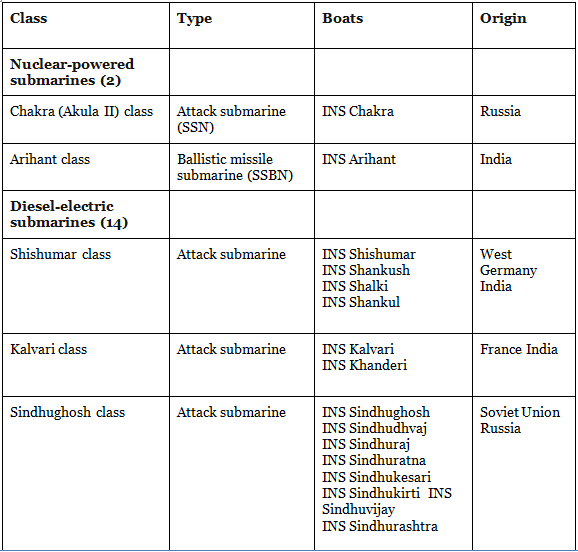
Planned
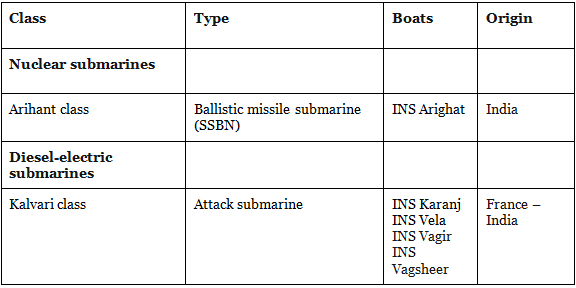
Ramjet Engine vs Scramjet Engine
Jet Engine – A jet engine is a machine that converts energy-rich, liquid fuel into a powerful pushing force called thrust. The thrust from one or more engines pushes a plane forward, forcing air past its scientifically shaped wings to create an upward force called lift that powers it into the sky.
A ramjet is a form of air-breathing jet engine that uses the vehicle’s forward motion to compress incoming air for combustion without a rotating compressor. Fuel is injected in the combustion chamber where it mixes with the hot compressed air and ignites.
Ramjets work most efficiently at supersonic speeds around Mach 3 (three times the speed of sound) and can operate up to speeds of Mach 6. However, the ramjet efficiency starts to drop when the vehicle reaches hypersonic speeds.
A scramjet engine is an improvement over the ramjet engine as it efficiently operates at hypersonic speeds and allows supersonic combustion. Thus it is known as Supersonic Combustion Ramjet or Scramjet.
Air Breathing Propulsion System which uses hydrogen as fuel and oxygen from the atmosphere air as the oxidizer.
Unmanned Aerial Vehicles
Drones are unmanned aerial vehicles (UAV) either controlled by ‘pilots’ from the ground or increasingly, autonomously following a pre-programmed mission. Drones basically fall into two categories: those that are used for reconnaissance and surveillance purposes and those that are armed with missiles and bombs.
UAVs typically fall into one of six functional categories (although multi-role airframe platforms are becoming more prevalent):
- Target and decoy – providing ground and aerial gunnery a target that simulates an enemy aircraft or missile
- Reconnaissance – providing battlefield intelligence
- Combat – providing attack capability for high-risk missions (see Unmanned combat air vehicle)
- Logistics – UAVs specifically designed for cargo and logistics operation
- Research and development – used to further develop UAV technologies to be integrated into field deployed UAV aircraft
- Civil and Commercial UAVs – UAVs specifically designed for civil and commercial applications
UAV of India
Nishant
Nishant is a multi mission Unmanned Aerial Vehicle with Day/Night capability used for battlefield surveillance and reconnaissance, target tracking & localization, and artillery fire correction.
Rustom
Rustom (Warrior) is a Medium Altitude Long Endurance unmanned combat air vehicle (UCAV) being developed by the Defence Research and Development Organisation.
- The design for Rustom UAV has been derived from National Aerospace Laboratories’ light canard research aircraft developed under the leadership of late Prof Rustom Damania.
- It will replace the Heron UAVs of the Indian armed forces.
- Rustom UAV will be able to enter 250 km inside the enemy territory and can carry a variety of cameras and radars for surveillance.
- Rustom-H variant is a multi altitude long endurance UAV that has a twin-engine for carrying out surveillance and reconnaissance missions. It will have a payload capacity of 350 kg.
Variants of Rustom
- Rustom I tactical unmanned aerial vehicle with the endurance of 12 hours. The design of Rustom I will be based on National Aerospace Laboratories’ LCRA.
- Rustom H will be a larger unmanned aerial vehicle having a flight endurance of more than 24 hours. The design will be different from Rustom I and will have a comparatively higher range and service ceiling
- Rustom II will be an unmanned combat aircraft based on the Rustom H model.
UAV Panchi
It is the wheeled version of unmanned aerial vehicle (UAV) Nishant, capable of taking-off and landing by using small airstrips. Panchi UAV has autonomous flight capabilities and is controlled from a user friendly Ground Control Station (GCS).
AURA
AURA is stealth UCAV, capable of releasing missiles, bombs and precision-guided munitions.
|
146 videos|358 docs|249 tests
|
FAQs on Defence Technology in India - Science & Technology for UPSC CSE
| 1. What are the major defense technologies being developed in India? |  |
| 2. How is India promoting indigenous defense technology development? |  |
| 3. What is the significance of defense technology in India's defense strategy? |  |
| 4. How is India collaborating with other countries in defense technology development? |  |
| 5. What are the future prospects of defense technology in India? |  |
|
146 videos|358 docs|249 tests
|

|
Explore Courses for UPSC exam
|

|
